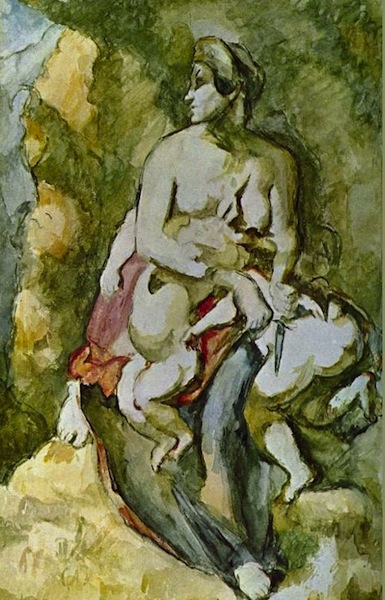CEZANNE & DE KOONING
These two pieces start in very different places, but because of a similar attitude about surface, the results are strikingly similar.
Both begin with white tones held together by intermittent black lines. Both employ the same palette: green, red, orange, and blue, although the predominance of greens and reds is reversed. Both have a choppy surface constructed of short, abrupt touches. There are more large, unifying shapes in the Cezanne, but they are treated as textures in much the same way as the de Kooning..
Paul Cezanne – copy of Delacroix’s ‘Medea’ c. 1880 Willem de Kooning – Woman 1 1952
For comparison, here is the Delacroix that Cezanne was copying. It’s divided into large areas of dark and light with the

purpose of dramatizing the action. The bodies are bright, coherent shapes. Medea’s gown is dark, to set off the children’s flesh tones. The background, right, is light to contrast with Medea’s hair; the foreground is dark with a little path in the middle so that the eye goes into the space as if it were a stage, and then moves upward to the bodies. Color is reserved.
Cezanne has recast the whole in light to middle tones, which has the effect of flattening the picture plane. His foreground is a light shape; the foot cuts to the bottom edge, which de-dramatizes the space by making the corners shapes rather than the foreground of a stage. The figures are far less coherent because Cezanne is exploring all the little local possibilities of shape and tone, and making each bit interesting, rather than disciplining the parts to an overriding whole. Obviously he respects the Delacroix, and is learning from it–he keeps the ominous shadow over Medea’s face, for example, and gives her head a more willful, less regretful tilt–but the lessons he’s learning are of his own devising.
So from Delacroix to Cezanne, a huge leap from storytelling to the exploration of surface. From Cezanne to de Kooning another step, but not so huge. De Kooning flattens the picture plane more than Cezanne by enlarging the figure and treating the marginal shapes more actively. And interestingly, while Cezanne is undercutting drama, which seems the modernist direction, de Kooning is going back to it big time. His women are called bitch goddesses–very in your face.
This piece is a reprise of 11/12/11.

